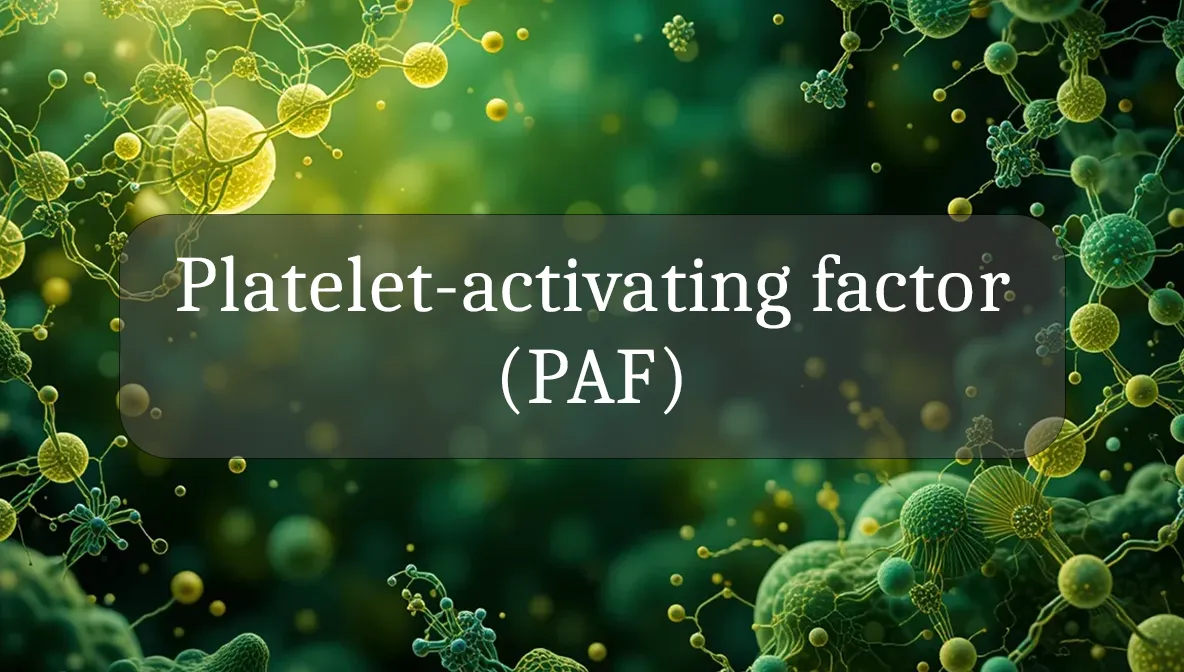Body Signal That Drives Inflammation and Healing
Platelet-activating factor (PAF) is like your body’s rapid-response team, a small molecule that rallies platelets and immune cells to manage inflammation, clotting, and healing. It’s a key player in daily wellness, helping your body respond to injuries or infections, but it can cause issues when overactive. Let’s explore what PAF is, how it supports your health, and practical ways to keep it balanced—all in a clear, friendly way to empower your wellness journey.
Chemical Identity and Type
Platelet-activating factor (PAF) is a lipid-based molecule belonging to the phospholipid family, derived from cell membrane components like arachidonic acid and other fatty acids. It’s produced on demand by cells such as platelets, white blood cells (e.g., neutrophils, macrophages), and endothelial cells through enzymatic pathways. PAF acts as a body signal, binding to specific receptors to trigger inflammation, blood clotting, and immune responses. It’s not stored but made as needed during injury or immune challenges.
Biological Role and Benefits
PAF is your body’s quick-action coordinator, supporting healing and defense. Here’s how it helps your wellness:
- Blood Clotting: PAF activates platelets to form clots, stopping bleeding from cuts or injuries.
- Inflammation Response: It recruits immune cells to fight infections or repair damaged tissues, promoting recovery.
- Immune Defense: PAF enhances white blood cell activity, helping clear bacteria, viruses, or allergens.
- Vascular Health: It regulates blood vessel tone, supporting circulation during stress or injury.
- Wound Healing: PAF guides immune cells to injury sites, speeding up tissue repair.
When balanced, PAF boosts your resilience, recovery, and overall vitality.
Dietary or Natural Sources
Your body makes PAF from lipids like arachidonic acid, found in omega-6 fatty acids in your diet. Key sources to support PAF-related processes include:
- Animal-Based: Eggs, beef, chicken, and fish (rich in arachidonic acid).
- Dairy: Milk, yogurt, and cheese.
- Plant-Based: Soybeans, peanuts, and vegetable oils (e.g., corn, sunflower).
- Nutrient Boosters: Omega-3 fatty acids (salmon, flaxseeds), vitamin C (oranges, bell peppers), zinc (oysters, seeds), and antioxidants (berries, turmeric) help balance PAF activity by reducing excessive inflammation.
- Anti-Inflammatory Foods: Ginger, garlic, and green tea may calm overactive PAF effects.
No PAF supplements exist, as it’s made in the body. Omega-3 supplements (1–2 grams daily) or antioxidant supplements (e.g., vitamin C, 500–1,000 mg daily) can help regulate PAF activity. Aim for a balanced omega-6 to omega-3 ratio (4:1 or lower) to prevent excess inflammation.
Signs of Imbalance or Dysfunction
PAF imbalance, typically from overproduction, can lead to excessive inflammation or clotting. Signs include:
- Excess PAF:
- Chronic inflammation, causing joint pain or swelling (e.g., in arthritis).
- Allergic reactions like itching, hives, or asthma symptoms.
- Increased clotting risk, potentially leading to heart issues or stroke.
- Digestive discomfort or skin redness from overactive immune responses.
- Low PAF (Rare):
- Slow clotting or delayed wound healing.
- Weakened immune responses to infections.
Overproduction may stem from high omega-6 intake, stress, or conditions like asthma, allergies, or heart disease. Underproduction is rare but could occur with lipid metabolism issues.
Supporting Optimal Levels or Function
To keep PAF balanced and maintain its benefits, try these practical steps:
- Eat Balanced Fats: Include omega-3-rich foods (salmon, chia seeds) and limit omega-6-heavy oils (corn, soy) to moderate PAF production.
- Boost Anti-Inflammatory Nutrients: Eat vitamin C (berries, peppers), zinc (seeds, oysters), and antioxidants (turmeric, blueberries) to reduce excess inflammation.
- Stay Active: Moderate exercise like walking or yoga (3–5 times weekly) supports healthy inflammation and circulation.
- Get Enough Sleep: Aim for 7–9 hours to regulate immune responses and reduce stress-driven PAF activity.
- Manage Stress: Chronic stress can boost PAF production; try meditation, deep breathing, or mindfulness.
- Stay Hydrated: Drink 8–10 cups of water daily to support circulation and immune function.
- Consider Supplements: Omega-3s (1–2 grams daily) or quercetin (500 mg daily, found in onions) may help balance PAF effects, but consult a doctor first.
Safety, Interactions, and Precautions
PAF is naturally produced and safe when balanced, but consider these points:
- Chronic Inflammation: Conditions like asthma, allergies, or heart disease involve overactive PAF and may require medical management.
- Medications: Nonsteroidal anti-inflammatory drugs (NSAIDs) or antihistamines may affect PAF activity; consult your doctor if on these treatments.
- Supplements: Omega-3s or antioxidants are safe but may cause mild digestive upset in high doses (e.g., above 3 grams for omega-3s).
- Allergies: Fish-based omega-3 supplements may trigger reactions in sensitive individuals.
- Heart Risks: Excessive PAF can increase clotting risks; those with heart disease should prioritize anti-inflammatory diets.
Prioritize a balanced diet and lifestyle to regulate PAF activity naturally.
Fun Fact
Did you know PAF was discovered because it makes platelets stick together like tiny superheroes to stop bleeding? Its name literally comes from its power to activate platelets in a flash!
Citations
- National Institutes of Health. (2023). Platelet-activating factor and inflammation. MedlinePlus.
- Mayo Clinic. (2024). Nutrition for immune and cardiovascular health.
- Cleveland Clinic. (2022). The role of PAF in clotting and inflammation.
- World Health Organization. (2020). Nutrient requirements for immune health.
- National Institute of Allergy and Infectious Diseases. (2023). PAF in immune responses.

